________________
The Ramayana Culture in Karnataka
Jainism
Vasantha Kumari
The epic story of the Rāmāyana which has appealed to the imagination of the Indians has not only fascinated them down the ages but it has also had its influence on the general Indian way of thought and life. This has resulted in finding its expression in varied forms in Hinduism, Jainism and Buddhism, in other words, what may be described as Indianism. It is this popular appeal which indeed explains the secret of its survival.
The study of Jaina Rāmāyaṇa presents an interesting picture, because Rāma in Jainism has occupied the place of Baladeva, amongst the Tri-sasti-salākā-mahāpurusa and not that of Avatāra-purusa as he is generally imprinted in Vedic Brahmanical Rāmāyaṇas. In other words, the mythological frame of the Jaina Rāmāyana is absolutely different in spirit and atmosphere from the Vedic Brahmanic frame.1
Rāma, Lakşmaņa and Rāvaņa form the eighth set of Baladeva, Vāsudeva and prati-Vasudeva. Baladevas are of gentle and sobre temperament while Vasudevas are violent and impetuous. Since Rama is considered to be Baladeva, he immediately attains liberation. Hence the Jaina scripture upholds Rāma as Siddha Paramātma.
Vimala Sūri is stated to have been the earliest amongst the prominent writers to record the complete narrative story of Rāma in the Jaina version. The date of Vimala Sūri Ācārya has been ascribed to 1st Century AD.3 The tradition of Vimala Sari was followed for centuries by the Jaina writers until Guņabhadrācārya, who. composed Uttara.
1 H. C. Bhayani "The Narrative of Rāma in the Jaina Tradition', Bhāratiya Vidya,
Vol. XXV, pp. 18-25. 2 Ibid., p. 20. 3 V. M. Kulakarni, Story of Rāma in Jaina Literature.
Jain Education International
For Private & Personal Use Only
www.jainelibrary.org




